100416_YKBP_A9.pdf



Broadcaster Press 9
October 4, 2016 www.broadcasteronline.com
Advantages to
Physical Therapy
to Relieve Pain
Improve Indoor Air Quality
in Advance of Winter
Upon the arrival of winter, people in regions where winter is marked by cold weather tend
to spend significantly more time indoors. Because windows tend to be closed during winter,
indoor air quality can suffer, making conditions inside a home less than desirable.
According to the American Lung Association, poor air circulation in a home can promote the
spread of bacteria and viruses. Once such bacteria or viruses are inhaled, coughs, colds and
flu can spread. In addition, asthma and allergy sufferers may experience worsening symptoms
thanks to the presence of endotoxins, which are substances that come from the broken-down
cells of dead bacteria.
Because many people spend significantly more time indoors during winter than other times
of the year, it’s essential that they take measures to improve indoor air quality in the months
ahead.
• Cut back on chemicals. It’s ideal to avoid heavy chemical usage inside a home throughout
the year, but it’s especially important to do so during winter. Solvent-based cleaners or cleaning
products with strong fragrances can negatively affect indoor air quality and potentially trigger
allergic reactions. In lieu of chemically-enhanced cleaning products, use natural products that
get the job done without sacrificing indoor air quality.
• Stop smoking indoors. Tobacco smoke can affect smokers and nonsmokers alike. The Centers for Disease Control and Prevention note that secondhand smoke causes numerous health
problems in infants and children. Those include more frequent and severe asthma attacks and
respiratory infections. In addition, reports from the U.S. Department of Health and Human Services have linked secondhand smoke to an increased risk of sudden infant death syndrome.
Adults exposed to secondhand smoke are at greater risk for coronary heart disease, stroke and
lung cancer. Tobacco smoke contains thousands of pollutants that can greatly diminish indoor
air quality, so make sure smokers limit their smoking to outside the home throughout the year,
but especially during winter.
Chronic pain affects people all around the world, greatly impacting sufferers’ quality of life.
According to the American Academy of Pain Medicine, recent reports have indicated more
than 1.5 billion people worldwide experience chronic pain. Common complaints include lower
back pain, headache, neck pain, or neurogenic pain, which is pain resulting from damage to
peripheral nerves.
Pain can impact people in many ways, as some people can tolerate discomfort better than
others. Chronic pain may result in missed time at work, depression, anger, and an inability to
live a full life. According to a recent Institute of Medicine Report: Relieving Pain in America:
A Blueprint for Transforming Prevention, Care, Education, and Research, pain is a significant
public health problem that costs society at least $560 to $635 billion annually.
To cope with pain, many people rely on over-the-counter and prescription medications. This
reliance on drugs has helped to fuel pain medication addictions that can lead to other drug
abuse. The National Institute on Drug Abuse says research now suggests that abuse of opioid
pain medications may actually open the door to heroin use. Some individuals report switching to heroin because it is cheaper and easier to obtain than prescription opioids. A safer and
sometimes more effective method of pain relief than opioids, physical therapy can help a person get back on track and feel much better in the process.
The American Physical Therapy Association says while surgery and prescription drugs can be
the best course of treatment for certain diagnoses, there is increasing evidence that conservative treatments like physical therapy can be equally effective and cheaper treatment plans for
many conditions. Physical therapy can be as effective as surgery for meniscal tears and knee
osteoarthritis, rotator cuff tears and spinal stenosis, among other conditions.
When a patient is prescribed physical therapy, a therapist will develop a treatment plan that
addresses the specific needs of the patient. This is essentially a collaboration between patient
and physical therapist. Therapists are experts in improving mobility and motion and have studied extensively to that end. Because weakness or stiffness may be contributing to pain, therapists try to address the source of the pain and relieve the pain itself.
Physical therapy may include exercises that stretch the body and improve flexibility. Strengthening exercises will help work on core muscles as well as other parts of the body to prevent
injury down the road. Therapy may target specific areas of pain. Because of their expertise,
therapists may be able to assess posture, gait and other attributes that may be contributing to
injury and make suggestions to reduce recurrence.
In addition to the therapies mentioned, a combination of massage and other work may be
included in a physical therapy plan. This may include TENS and ultrasound. According to WebMD, Transcutaneous Electrical Nerve Stimulation, or TENS, uses a device to send a low-voltage
electric current to the skin over the area where you have pain. Ultrasound sends sound waves
to the places you have pain. Both of these options may help to block pain messages to the brain
and offer relief.
Chronic pain can be debilitating. However, physical therapy is often an effective way to combat chronic pain and help individuals find relief and return to living full lives.
• Take off your shoes when entering the home. Snowy conditions often require a home’s inhabitants and guests to remove their footwear upon entering a home, but it helps to remove
footwear in a mudroom or just inside the front door when entering a home even when it’s not
snowing. Shoes can pick up dirt, dust and a host of other particles during winter, and if tracked
inside those unwanted guests can negatively affect indoor air quality.
• Routinely inspect bathrooms for mold. During winter, mold can grow in rooms that are exposed to moisture but not properly ventilated. In many homes, that’s the bathroom. Even if a
bathroom has a ventilation fan, routinely inspect the ceiling and shower for mold growth. Exposure to mold can cause a host of negative side effects, including nasal and sinus congestion
and sore throat. Mold also can exacerbate asthma symptoms.
Improving and maintaining indoor air quality in winter can help a home’s inhabitants stay
healthy during the colder months.
VERMILLION
HOUSEHOLD HAZARDOUS
WASTE COLLECTION
Why can’t I just throw Household Hazardous Waste (HHW) away?
Certain types of HHW have the potential to cause physical injury to sanitation workers,
contaminate septic tanks or wastewater treatment systems if poured down drains or toilets, and
present hazards to children and pets if left around the house. Read product labels for disposal
directions to reduce the risk of products exploding, igniting, leaking, mixing with other chemicals,
or posing other hazards on the way to a disposal facility. Even empty containers of HHW can pose
hazards because of the residual chemicals that might remain.
When and where can I dispose of my HHW?
On October 7th, from 2:00 PM to 6:00 PM, bring your HHW to the
Missouri Valley Recycling Center. The cost per vehicle is $10.
The Missouri Valley Recycling Center is located at:
840 N Crawford Rd • Vermillion SD, 57069
Vermillion Household
Hazardous Waste Collection
When: October 7th, 2:00 PM to 6:00 PM
Where: Vermillion Recycling Center
Why: To get rid of hazardous waste that can
harm you, your family or the environment.
Examples of HHW
•Latex and Oil Based Paints
•Household Cleaning Products
•Fluorescent Light Bulbs
•Batteries
•Pesticides
•Anti-Freeze
•Oil
BrougHt to you By: The CiTy of Vermillion
Missouri Valley recycling • clay county
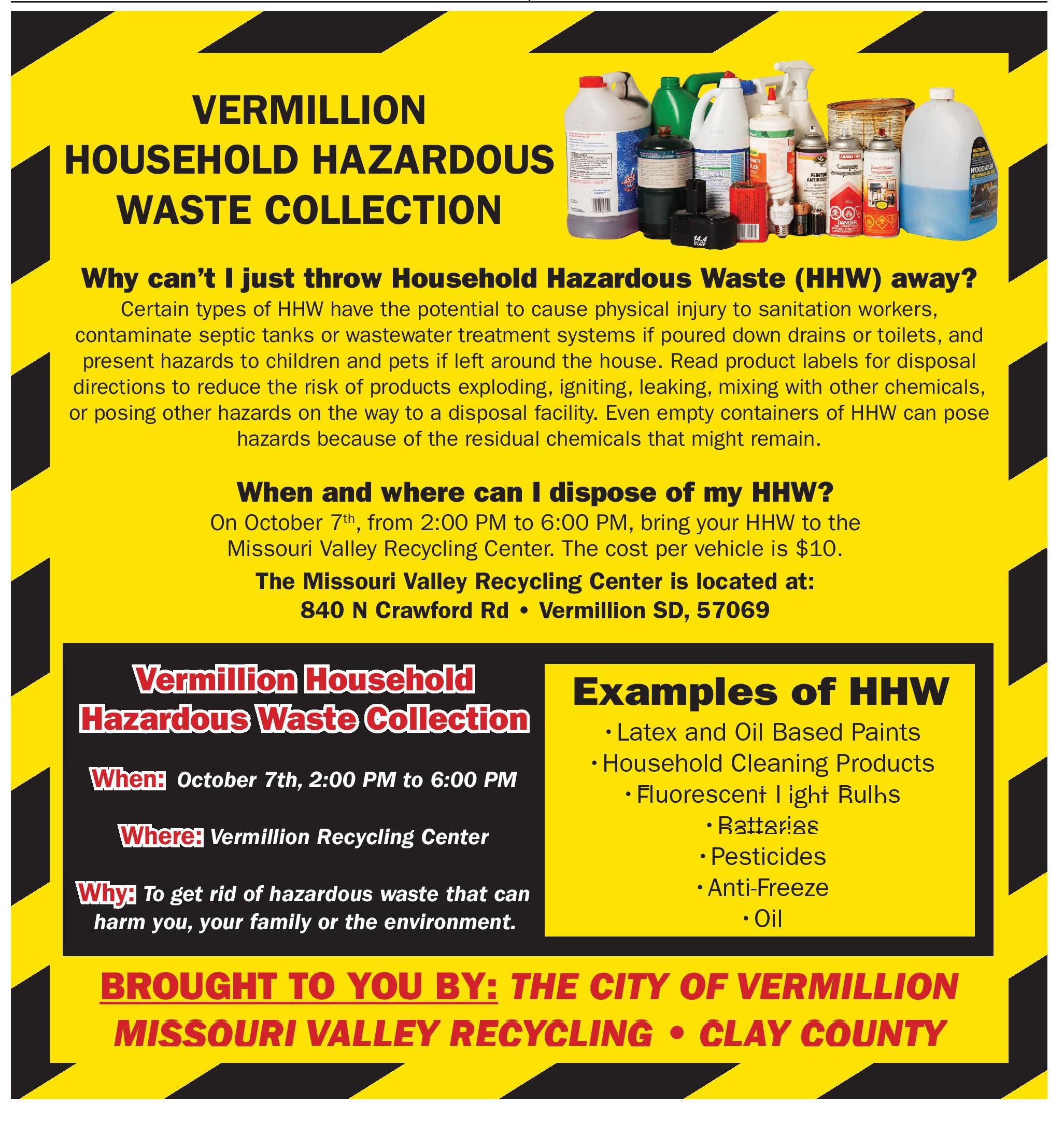




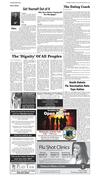


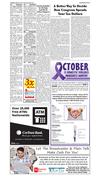



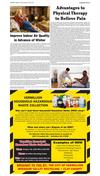
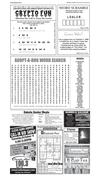


 Previous Page
Previous Page






